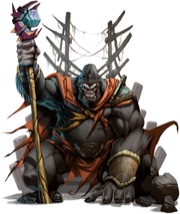
| |
| Illustration by Mauricio Herrera |
Monkey See, Monkey Do? An FAQ on Intelligent AnimalsTuesday, March 29, 2011
This is an odd FAQ item that we see pop up on occasion in a variety of different places. What happens when an animal gets an increased Intelligence score? There are a lot of different ways this can happen, and a number of strange routes that a GM could take when resolving this issue. Today, we are going to attempt to untangle this particular knot and see if we can't come up with some guidelines that make sense.
There are many ways an animal can gain intelligence. It can gain hit dice and apply its ability score boost to Int. It can gain the advanced simple template. A druid could cast awaken on it. Regardless of the source, an increase in Int comes with all of the standard bonuses, such as additional skill points. Once a creature's Int reaches 3, it also gains a language. This is where things start to get tricky. "Really, now my pet monkey can talk?" Well, not really. Allow me to explain.
Gaining a language does not necessarily grant the ability to speak. Most animals do not possess the correct anatomy for speech. While a very intelligent dolphin might be taught to understand Common, there's no way for him speak it. There is also the issue of learning the language. The rules are mostly silent on this front, due to ease of play for PCs, but a GM should feel safe in assuming that it might take years to actually teach Common to an intelligent animal. All of this, of course, assumes that the animal even bothers to fill that language slot. Possessing the ability to use a language does not necessarily mean that such an ability is utilized.
Another aspect of intelligent animals is tool use. There are a number of feats that convey an understanding and the proper use of weapons and armor. Generally speaking, these feats are off-limits to animals, but when their intelligence reaches 3, the rules state that they can use any feat that they are physically capable of using. Some people take this to mean that they can equip their animal companion in chainmail and arm him with a greatsword given the correct feats. While you could interpret the rules in this way, the "capable of use" clause is very important. Most weapons require thumbs to use properly, and even then, few animals would choose to use an artificial weapon in place of the natural weapons that have served them all their life. It's what they were born with, after all, and virtually no amount of training will change that. In the end, the GM should feel free to restrict such choices if he feels that they take away from the feel of his campaign. The rules themselves are left a little vague to give the GM the latitude to make the call that's right for his campaign.
The Handle Animal skill functions similarly no matter how intelligent an animal becomes. A character must still make Handle Animal checks to train his animal and get him to perform the appropriate tasks. A GM should, however, make exceptions in the case of how such an intelligent animal might react in absence of instructions. It might not know to unlock a door to escape a burning building—as that's a fact that's learned over time and experience—but a smart animal might have a better chance of finding a way out.
The spell awaken changes much of this, however, since the spell is specifically designed to raise a creature up to sentience. GMs should feel free to loosen the above guidelines in the case of animals who have been the subject of this spell (since they become magical beasts), but should also note that awakened animals do not continue to serve as animal companions or familiars. Such creatures gain their own desires and feelings, and may seek to set out on their own to determine their own fate. They may not leave right away, but GMs should keep in mind that eventually any such creatures (or trees) may wish to leave to find their fortune.
Note that while the monster guidelines talk about a maximum Int for an animal, this only applies to the creation process. Giving an animal a higher Intelligence score does not somehow transform it into a magical beast, unless the effect says otherwise, such as in the case of awaken. Animals can grow to have an Int higher than 2 through a variety of means, but they should not, as a general rule, be created that way.
Well, that about wraps up our look at intelligent animals. We hope these guidelines and ideas help inform the issue in your game. If you have any further questions on the topic, ask them in the comments to this blog. Until next time!
Jason Bulmahn
Lead Designer